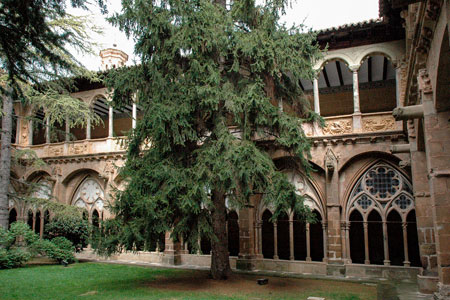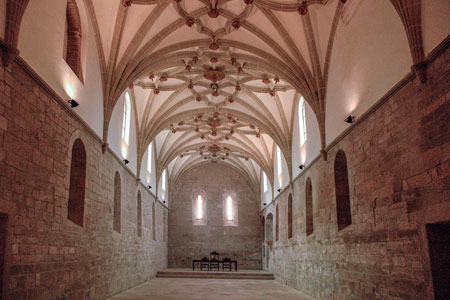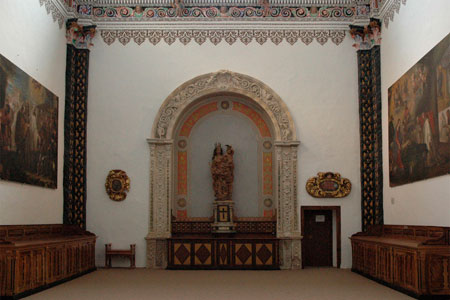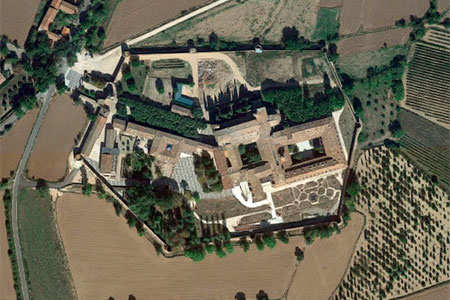The foundation of the monastery of Santa María de Veruela is linked to the desire of García Ramírez of Navarre, the Restorer, (1134-50) to repopulate this territory. In this context, in 1145 the king donated the territory to the Cistercians from the Abbey of Escaladieu (Occitania).
The place enjoyed the protection of the authorities and Ramon Berenguer IV (1154), his son Alfonso II the Chaste and Pope Alexander III confirmed and extended the founding endowment. Thanks to this patronage, the monastery became the centre of a powerful domain, especially in the 13th century, under the protection of James I. The monastery of Santa María de Herrera (Burgos) was founded from Veruela, and ancient sources also mention the monastery of Saya, or Saja, which would eventually become part of Herrera. In the 14th century, the place suffered the effects of the war between Peter the Ceremonious (Crown of Aragon) and Peter the Cruel of Castile, which particularly affected these lands and also the monastery itself.
In the 15th century, the monastery fell into decline and from 1472 onwards it began to suffer the rule of commendatory abbots. A century later, the monastery enjoyed a major recovery, which enabled new building work to be undertaken on various parts of the monastery. It was abandoned by the Cistercians following the disentailment (1835), between 1877 and 1972 the site was occupied by the Jesuits and is now public property.
Affiliation of Veruela
According to Originum Cisterciensium (L. Janauschek, 1877)- CABANES, María de los Desamparados; i altres, ed. (2017). Documentos del Monasterio de Santa María de Veruela. Vols. I-V. Saragossa: Anubar
- CALVO, José Ignacio; coord. (2006). Tesoros de Veruela. Diputación Provincial de Zaragoza
- CRIADO, Jesús (coord.) (1993). Monasterio de Veruela. Guía histórica. Diputación de Zaragoza
- DAILLIEZ, Laurent (1985). Veruela, monasterio cisterciense. Diputación. P. Zaragoza
- DAILLIEZ, Laurent (1987). Los orígenes de Veruela. El Císter. Órdenes religiosas zaragozanas. Saragossa: Inst. Fernando el Católico
- DE LA FUENTE, Vicente (1866). España Sagrada. Las santas iglesias de Tarazona y Tudela. Vol. L. Madrid: J. Rodríguez
- DELGADO, Javier (1996). Job en Veruela (Esculturas del claustro gótico del monasterio de Veruela). Saragossa: Ibercaja
- DIMIER, M.A. (1959). Morimond et son empire. Mémoires de la Société historique et archéologique de Langres. Langres
- JANAUSCHEK, Leopoldus (1877). Originum Cisterciensium. Vol. 1. Viena
- LIAÑO MARTÍNEZ, Emma (2009). La época del Císter y de las nuevas catedrales en la Corona de Aragón. Arte de épocas inciertas. De la Edad Media a la Edad Contemporánea
- MANRIQUE, Angel (1642-59). Cisterciensium Annalium. Lió: L. Anisson
- MOYA, José Gabriel (1990). Notas sobre Sajazarra medieval, urbanismo, cerca, fortaleza. Brocar, núm. 16
- RODRÍGUEZ, Francisco Saulo (2017). Documentos del siglo XIV del Monasterio de Santa María de Veruela no recogidos en su colección diplomática. Turiaso, núm. 23
- YEPES, Antonio de (1621). Coronica general de la orden de San Benito. Valladolid: F. F. De Cordova




































